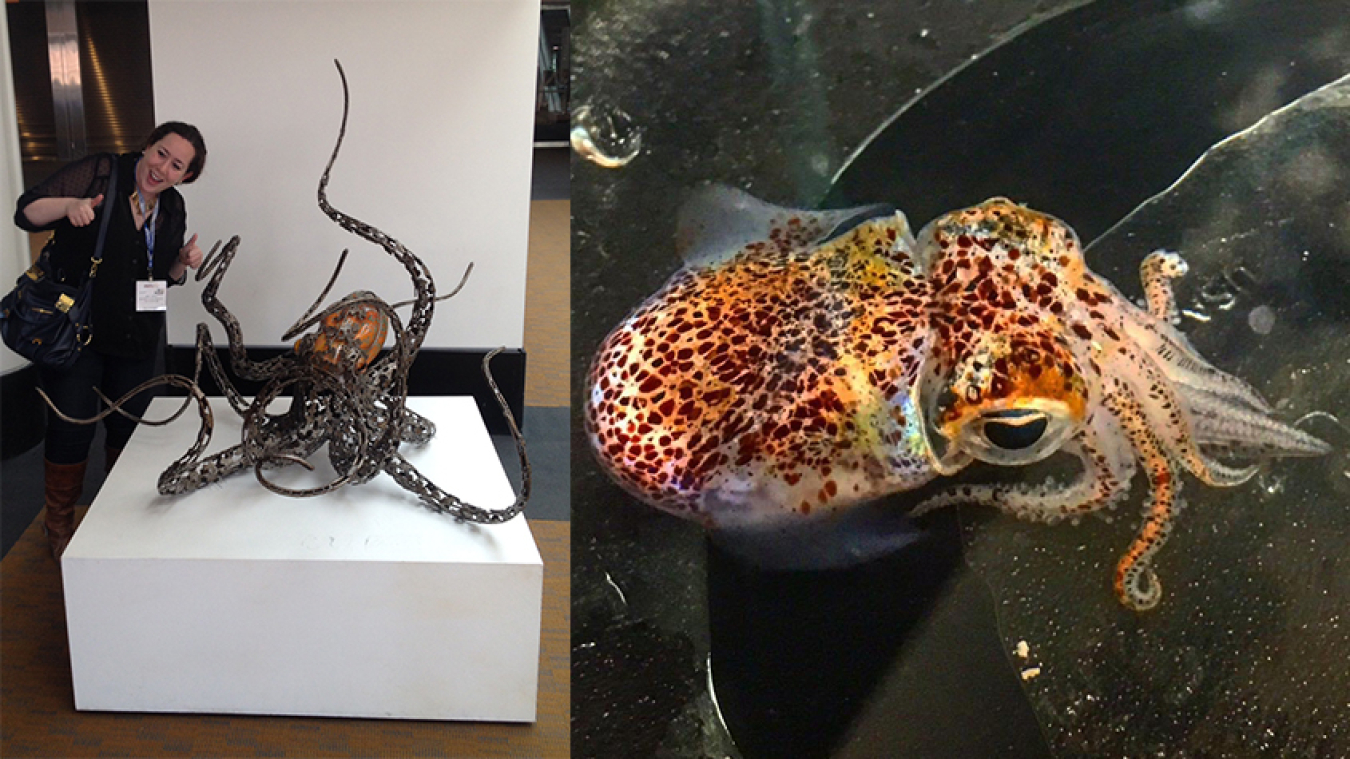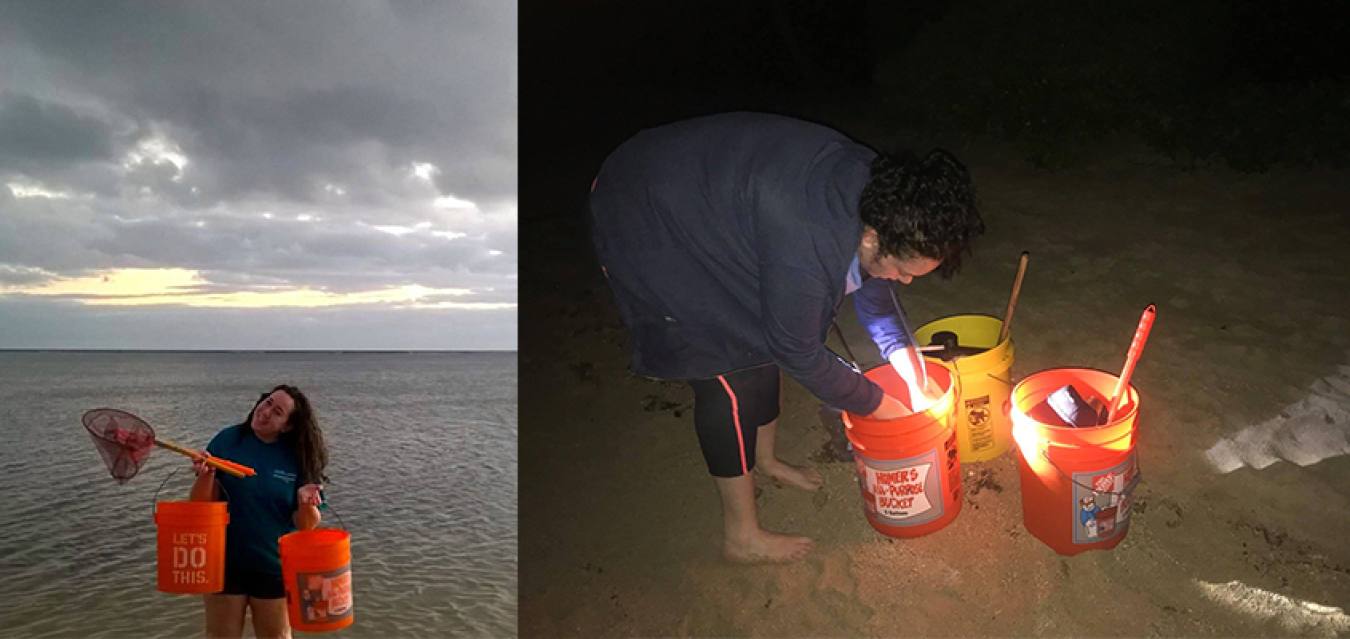All the skyscrapers, traffic, and factories used to remind Nina Joffe of warnings in Dr. Suess’ The Lorax. As an American Association for the Advancement of Science fellow, she helps marine energy expand and coexist with marine wildlife and ecosystems.
Water Power Technologies Office
February 7, 2023“It’s such a beautiful view,” Nina Joffe remembers thinking when, as a child, she peered out the car window as her family drove from their home in New Jersey across the Hudson River and into New York City. But something bothered her about that view. All the skyscrapers, traffic, and factories reminded her of a world her favorite childhood book, Dr. Suess’ The Lorax, warned about.
Nina Joffe, a 2021 AAAS Science and Technology Policy Fellow, is heeding the advice of her favorite childhood book, The Lorax, by helping communities coexist with the environment.
“We have all this human activity. I remember thinking that it’s impossible to go anywhere and see a pretty view without a phone line or a tower or a bridge,” said Joffe, who is working in the U.S. Department of Energy’s Water Power Technologies Office (WPTO) as a 2021 American Association for the Advancement of Science (AAAS) Science and Technology Policy fellow.
In The Lorax, a squat, orange creature warns the narrator not to chop down trees. But the narrator doesn’t listen; soon, his treeless world becomes a place of “slow-and-sour” winds and “dank midnights” from which all birds, except crows, have fled.
Joffe, unlike that narrator, is not only listening to what the Earth and its creatures are telling us; she’s also spreading the word. During her undergraduate and graduate studies at Rider University and New Mexico State University, respectively, she studied how creatures evolved together over thousands of years—and how human activities might be affecting these ancient partnerships. She focused specifically on the Hawaiian bobtail squid—which is just a few inches long and speckled like a wildcat—and its bioluminescent bacteria. Now, for her two-year fellowship, Joffe is helping humans adopt less destructive activities and coexist better with the Earth
Ripple Effect
WPTO’s Ripple Effect series features individuals whose impactful work will help advance hydropower and marine energy technologies to achieve a clean energy future.
Joffe shared how she fell into science (and nature’s “magnificent” symbiosis, as she calls it), why she sees policy work as the best way to make immediate, tangible change, and how she’s working to build a symbiotic relationship among communities, clean energy, and the ocean.
What's your scientist origin story? How did you fall into science?
“Falling into science” is a good way to put it. It’s been a slow, uphill climb. As a kid, I was really into the environment, saving the rainforest, “don’t litter”—things like that.
Where did that environmental care come from? Your parents?
Not my parents. I was usually the one preaching environmental awareness. It just always made sense to me that we need to protect our environment. I was drawn to nature, taking care of the Earth, and the natural cycle of things.
And you continued to pursue that passion in college, right?
"It's been a slow, uphill climb," Joffe said of her journey into science. Although she originally pursued environmental science and sustainability, she ended up falling for symbiosis, the "magnificent" way creatures evolve together over thousands of years.
Yes, I was interested in studying environmental science and sustainability, but Rider University only had environmental science at the time, so that’s what I ended up focusing on. Surprisingly, I ended up enjoying my biology classes even more than my environmental classes and started working in a biology laboratory as a freshman. My professor asked me to work on a project in symbiosis, which is the interaction between two organisms to the benefit of either one or both, to identify, at a molecular level, a species of algae that lived inside salamander egg capsules alongside the developing embryo. I realized molecular biology was the science that I really enjoyed doing. I also fell in love with symbiosis. It’s magnificent to me that organisms can form these intricate relationships, evolving over thousands and thousands of years to rely on each other.
How did you continue to pursue your interest in symbiotic relationships and incorporate that into your academic career?
In graduate school, I wanted to understand how the environment and human activity might influence symbiotic relationships. I was interested by the Hawaiian bobtail squid’s symbiosis with the bioluminescent bacterium, Vibrio fischeri. There’s a specific tissue inside the squid, called the light organ, that has developed to house these bacteria. The squid detects the bacteria from a single cell and starts a whole suite of structural and functional changes that will allow the bacterium to get inside, reproduce, and grow to densities large enough to produce bioluminescence, which helps the squid camouflage when they’re out at night hunting.
I was also tragically inspired by coral reefs and coral bleaching. When coral’s symbiotic relationships with algae is disrupted, it can result in the die-off of corals and the loss of coral reefs. I wondered if this happens to other symbiotic relationships.
So, I developed a project to understand how ocean acidification—or increased acid levels due to higher concentrations of carbon dioxide in the atmosphere—may affect the symbiotic relationship between the squid and its bacteria. I also looked at what genes may be important in the stress response of the squid under acidic environmental conditions.
This project wasn’t entirely conclusive, but ocean acidification didn’t seem to affect the squid or bacteria in terms of establishing or maintaining their symbiotic relationship. In very controlled laboratory conditions, the squid still retained their bacteria, but there are a few genes that seem to be involved in or important for the squid’s stress response.

In graduate school, Joffe studied the Hawaiian bobtail squid to understand how human activities might be impacting relationships between animals and the bacteria they depend on.
What made you shift from laboratory research to more policy-focused work with your AAAS fellowship?
In the middle of my doctorate, I realized the benchwork I enjoy doing—molecular work—might not directly impact the issues that got me into science in the first place, such as conservation and climate change. I began to feel a stronger need to contribute to tangible solutions rather than just the knowledge itself. At that time, I took a Summer Science Policy Internship at the National Science Foundation, and that's what led me to policy and community work. Ever since then, the AAAS fellowship was my goal.
Well, congratulations on achieving that goal! What have you been working on so far?
At WPTO, I’ve been supporting three large portfolios. The first is environmental monitoring for marine energy—energy generated from river currents and ocean waves, currents, and tides. This work helps make sure these technologies can safely coexist with marine wildlife and ecosystems. I’ve also worked with our Power at Sea portfolio to strategize how industries, such as offshore seafood farming or marine carbon dioxide removal, could rely on marine energy for power. And I’ve been involved with the Energy Transitions Initiative Partnership Project, which works with remote, island, and islanded communities to transform their energy systems. Recently, I worked on a retrospective analysis of our applicant pools to identify indicators of successful applicants and potential areas of improvement in the application process to meet community needs and ensure everyone is given a fair chance.

In the Water Power Technologies Office, Joffe is helping communities coexist better with the Earth, which is far from a new role. Previously, she has volunteered to pick up trash at her local beach.
What excites you most about your work with WPTO?
I never made the connection that the science I was doing before could lead to the renewable energy space. I love how it ties together science and the things I care about—climate change, decarbonization, and making an impact on the world and local communities in a positive way. And it’s neat getting to work in marine energy, which is not as developed as, say, solar power. There’s a lot of creativity that can go into it.
What does this fellowship allow you to do that you wouldn’t be able to otherwise?
When you’re in academia, it’s hard to see what else is out there. This fellowship has given me a clear view of all the different opportunities in policy and government, as well as nonprofit work, philanthropy, and direct applications of science. It has given me a great perspective of how high-level science and knowledge can impact society for the better.
What would you tell someone considering a Science and Technology Policy fellowship with AAAS?
"When you’re in academia, it’s hard to see what else is out there," Joffe said. "This fellowship has given me a clear view of all the different opportunities in policy and government, as well as nonprofit work, philanthropy, and direct applications of science. It has given me a great perspective of how high-level science and knowledge can impact society for the better."
I would tell them to absolutely apply, even if they’re not sure science policy is the correct career path for them. This experience is truly unmatched in the perspective it gives you on how science is integrated into policy decisions. Even if you don’t pursue this type of work further, it still provides you with some fantastic nuggets of knowledge that will make your approach to science more informed and comprehensive in its potential broader impacts.
In an ideal world, what would you hope to accomplish?
Maybe I’m not following the path that I initially set out on, but I can see myself staying in the policy, government, or nonprofit worlds that connect science to community. I’m quite happy where I’m at in this space, so I’m taking time to enjoy it and be present in this moment before focusing on what’s next. So, I’m not sure where I see myself exactly, but I’ll definitely be doing the same type of work that I’m doing right now.
What advice do you have for others on a similar, nonlinear path?
Keep your mind open to new opportunities and take any you can find. Be willing to try new things; even if you don't like it, that’s OK. That’s still information learned. You can use that to get where you want to go.
Catch up on WPTO's other Ripple Effect profiles and Office of Energy Efficiency and Renewable Energy Clean Energy Champions. And stay in the know with WPTO! Receive the latest information on funding opportunities, events, and other news by subscribing to the Hydro Headlines and Water Column newsletters, as well as the comprehensive Water Wire newsletter.

